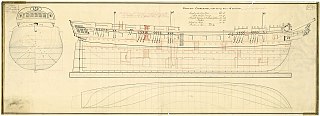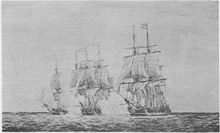
The second USS Boston was a 24-gun frigate, launched 3 June 1776 by Stephen and Ralph Cross, Newburyport, Massachusetts, and completed the following year. In American service she captured a number of British vessels. The British captured Boston at the fall of Charleston, South Carolina, renamed her HMS Charlestown, and took her into service. She was engaged in one major fight with two French frigates, which she survived and which saved the convoy she was protecting. The British sold Charlestown in 1783, immediately after the end of the war.
The first USS Lee was a schooner under the Continental Army during the American Revolutionary War. She was named for General Charles Lee.

The second Hancock was one of the first thirteen frigates of the Continental Navy. A resolution of the Continental Congress dated 13 December 1775 authorized her construction; she was named for the patriot and Continental congressman John Hancock. In her career, she served under the American, British and French flags.

Vice Admiral Sir George Collier was an officer of the Royal Navy who saw service during the Seven Years' War, the American War of Independence and the French Revolutionary Wars. As commander of the fourth-rate ship HMS Rainbow, he was one of the most successful British naval commanders during the opening stages of war with America. He achieved considerable success as one of the senior officers on the North American coast, conducting and organizing several highly effective raids and counter-strikes. He was superseded however, and returned to Britain to play a role in the closing events of the war in European waters, before moving ashore to start a political career. He enjoyed a brief return to service with the resumption of war with France, and achieved flag rank, but died shortly afterwards.

HMS Lively was a 20-gun post ship of the Royal Navy, launched in 1756. During the Seven Years' War she captured several vessels, most notably the French corvette Valeur in 1760. She then served during the American Revolutionary War, where she helped initiate the Battle of Bunker Hill. The French captured her in 1778, but the British recaptured her in 1781. She was sold in 1784.

Vestale was a Blonde-class 30-gun frigate of the French Navy. The Royal Navy captured her in 1761, but had to scuttle her in 1778 to avoid having the French recapture her. She was refloated and sold to the French in 1784. She returned to wartime service in 1794 as a privateer. The British recaptured her in 1798 and broke her up thereafter.

Surveillante was an Iphigénie-class 32-gun frigate of the French Navy. She took part in the Naval operations in the American Revolutionary War, where she became famous for her battle with HMS Quebec; in 1783, she brought the news that the war was over to America. She later took part in the French Revolutionary Wars, and was eventually scuttled during the Expédition d'Irlande after sustaining severe damage in a storm. The wreck was found in 1979 and is now a memorial.
Sixteen ships of the Royal Navy have borne the name HMS Alert, while another was planned:
HMS Ariel was a 20-gun Sphinx-class sixth-rate post ship of the Royal Navy. The French captured her in 1779, and she served during the American Revolutionary War for them, and later for the Americans, before reverting to French control. Her French crew scuttled Ariel in 1793 to prevent the British from recapturing her.

The Junon was a 32-gun Charmante class frigate of the French Navy

HMS Porcupine was a 24-gun Porcupine-class sixth-rate post ship of the Royal Navy built in 1777 and broken up in 1805. During her career she saw service in the American War of Independence and the French Revolutionary Wars.

Iphigénie was a 32-gun Iphigénie-class frigate of the French Navy, and the lead ship of her class. She was briefly in British hands after the Anglo-Spanish capture of Toulon in August 1793 but the French recaptured her December. The Spanish captured her in 1795 and her subsequent fate is unknown.

The Battle off Halifax took place on 28 May 1782 during the American Revolutionary War. It involved the American privateer Jack and the 14-gun Royal Naval brig HMS Observer off Halifax, Nova Scotia. Captain David Ropes commanded Jack, and Lieutenant John Crymes commanded Observer. The battle was "a long and severe engagement" in which Captain David Ropes was killed.

HMS Crescent was a 28-gun Enterprise-class sixth-rate frigate of the Royal Navy. Crescent was launched in 1779. The French captured her in 1781. She was wrecked in 1786.

The French frigate Aigle was launched in 1780 as a privateer. The French Navy purchased her in 1782, but the British captured her that same year and took her into the Royal Navy as the 38-gun fifth rate HMS Aigle. During the French Revolutionary Wars she served primarily in the Mediterranean, where she was wrecked in 1798.

Junon was a 40-gun Minerve-class frigate of the French Navy.

HMS Ceres was an 18-gun sloop launched in 1777 for the British Royal Navy that the French captured in December 1778 off Saint Lucia. The French Navy took her into service as Cérès. The British recaptured her in 1782 and renamed her HMS Raven, only to have the French recapture her again early in 1783. The French returned her name to Cérès, and she then served in the French Navy until sold at Brest in 1791.
The French brig Duc de Chartres was built between 1779 and 1780 at Le Havre as a 24-gun privateer. As a privateer she captured one British warship before in 1781 the Royal Navy captured her. The Royal Navy took her into service as HMS Duc de Chartres. She then captured several American privateers and armed merchant vessels, and one French naval corvette in a noteworthy single-ship action. The Navy sold Duc de Chartres in 1784.

The American frigate USS Hancock was captured by the British Royal Navy in a 1777 naval battle during the American Revolutionary War. The two highest ranking naval officers of the war battled each other off the coast of Nova Scotia. HMS Rainbow, under the command of British Admiral George Collier, captured USS Hancock, under the command of Captain John Manley.

The Action of 11 September 1778 was a minor naval engagement which took place off the French port of Brest during the American War of Independence, between the French frigate Junon and the Royal Navy frigate HMS Fox. During the engagement that followed, Junon outgunned Fox forcing her to strike.
















